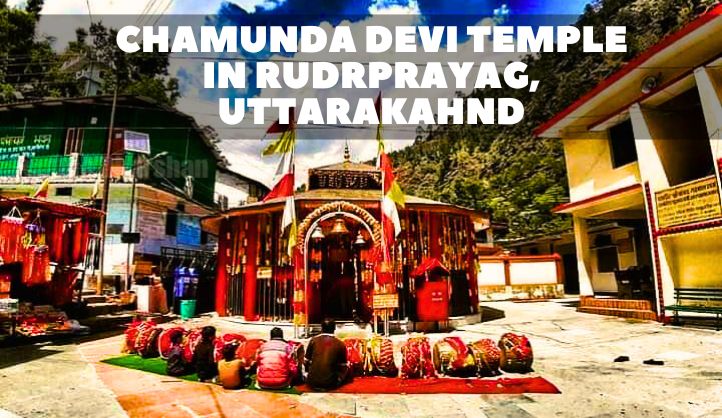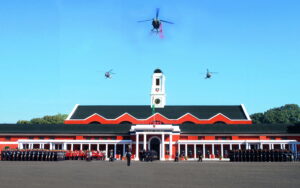Nestled amidst the majestic Himalayas, where the holy rivers Alaknanda and Mandakini converge, lies the quaint town of Rudraprayag, a significant pilgrimage site in Uttarakhand. This spiritual hub not only boasts the famed Rudranath Temple dedicated to Lord Shiva but also houses several other sacred spaces, each with its own unique history and significance. Among these gems is the Chamunda Devi Temple, a revered abode of the powerful Devi Chamunda.
The Fierce Mother: Unveiling the Legend of Chamunda Devi
Chamunda Devi, also known as Chamundi or Kali, is a fierce aspect of Durga, the embodiment of divine feminine power. Legends depict her as a fearsome slayer of demons, often depicted riding a lion and adorned with the skulls and severed limbs of her vanquished foes. Despite this fearsome imagery, Chamunda Devi is also seen as a protector, warding off evil and negativity. Her worship is believed to bring strength, courage, and liberation from negativity.
A Spiritual Haven: Exploring the Chamunda Devi Temple
The Chamunda Devi Temple in Rudraprayag embodies the essence of its presiding deity. While details about the temple’s origin remain shrouded in time, its location itself holds immense significance. Situated at the confluence of the Alaknanda and Mandakini, the temple is believed to be a point of immense spiritual energy. The confluence itself is considered sacred, symbolizing the union of divine feminine and masculine energies.
The architectural style of the temple leans towards the Nagara style, characterized by a shikhara (tower) rising above the sanctum sanctorum (inner sanctum). The exact details of the temple’s construction are not widely available, but its presence adds to the spiritual tapestry of Rudraprayag. Inside the sanctum sanctorum, devotees can offer prayers to the idol of Chamunda Devi, often depicted with eight arms, each wielding a weapon.
A Journey to the Temple: Reaching the Abode of Chamunda Devi
The Chamunda Devi Temple is located approximately 6 kilometers from Rudraprayag, at an elevation of about 1800 meters. While not as easily accessible as some other temples in the region, the journey itself adds to the pilgrimage experience. Devotees can reach the temple by taxi from Kali Math, a nearby temple complex. For the more adventurous, a 1.5-kilometer trek from Kali Math offers stunning Himalayan views and a chance to immerse oneself in nature’s serenity.
How to Reach
There are several ways to reach Chamunda Devi Temple in Rudraprayag, depending on your starting point and preferred mode of transportation. Here are some options:
- By Air: The nearest airport to Rudraprayag is Jolly Grant Airport (SGR) in Dehradun, which is about 160 kilometers away. From the airport, you can take a taxi or hire a car to reach Rudraprayag.
- By Train: The nearest railway station to Rudraprayag is Rishikesh Railway Station (RKSN), which is about 130 kilometers away. From the railway station, you can take a taxi or hire a car to reach Rudraprayag.
- By Road: Rudraprayag is well connected by road to major cities in North India. If you are traveling by road, you can take National Highway 58 (NH58) which passes through Rudraprayag.
Here are some additional details to consider when planning your trip to Chamunda Devi Temple:
- Best time to visit: The temple is open all year round, but the best time to visit is during the summer months (April to June) or the autumn months (September to November) when the weather is pleasant.
- Accommodation: There are a variety of hotels and guesthouses to choose from in Rudraprayag, to suit all budgets.
- Things to do: In addition to visiting the Chamunda Devi Temple, there are a number of other things to see and do in Rudraprayag, such as visiting the confluence of the Mandakini and Alaknanda rivers, hiking in the surrounding hills, or white water rafting on the Ganges River.
Beyond the Temple: Unveiling the Spiritual Significance of Rudraprayag
The Chamunda Devi Temple is just one piece of the rich spiritual tapestry that Rudraprayag offers. The town itself holds immense significance for devotees of Lord Shiva. It is believed to be the place where Lord Rudra (another name for Shiva) met the divine Nandis (bulls). The confluence of the Alaknanda and Mandakini is seen as a symbolic representation of the union of Shiva and Parvati, further amplifying the town’s spiritual aura.
A Timeless Tradition: Rituals and Festivals at the Chamunda Devi Temple
While information about specific rituals or festivals associated with the Chamunda Devi Temple is limited, general Hindu practices are likely followed. Devotees typically offer prayers, flowers, and other offerings to the Devi. Aarti (worship with lamps) is likely a regular practice, with devotees seeking blessings and protection from the fierce yet benevolent goddess. During major Hindu festivals such as Navratri and Dussehra, which celebrate the divine feminine, the temple might see an increase in visitors.
A Glimpse into Local Beliefs: The Significance of Chamunda Devi for the Community
The Chamunda Devi Temple holds a special place in the hearts of the local Rudraprayag community. Seen as a protector and a source of strength, the Devi is revered by many. While the temple might not be a major tourist attraction yet, it serves as a vital spiritual center for the local population.
Beyond the Physical: The Enduring Legacy of Chamunda Devi
The Chamunda Devi Temple transcends its physical structure. It represents the enduring legacy of the worship of Shakti, the divine feminine force. The fierce image of Chamunda Devi serves as a reminder of the power within us all, the ability to overcome negativity and emerge victorious. For devotees, the temple is a place of solace, a space to connect with the divine and seek blessings for a life filled with strength and protection.
Local Legends and Untold Stories: Unveiling the Temple’s Mystique
The rich tapestry of the Chamunda Devi Temple extends beyond historical accounts. Local legends weave a fascinating narrative around its origins. One popular story recounts a fierce battle between Goddess Durga and the demons Chanda and Mundaka. Chamunda Devi, a manifestation of Durga’s wrath, emerged victorious, slaying the demons and establishing her abode at the confluence, a place believed to possess immense spiritual power.
Another legend narrates the tale of a king tormented by malevolent forces. Guided by a divine vision, the king embarked on a pilgrimage and reached the confluence. There, he encountered a radiant woman who vanquished the evil forces plaguing his kingdom. In gratitude, the king built a temple dedicated to the Devi, forever enshrining her presence at the sacred site.
These legends passed down through generations, not only add to the temple’s mystique but also highlight the deep-rooted belief in the Devi’s protective power. They serve as a reminder of the timeless struggle between good and evil, and the unwavering faith that humanity places in the divine for protection and guidance.
Unveiling the Symbolism: Decoding the Devi’s Form
The fierce portrayal of Chamunda Devi at the temple is rich in symbolism. Her eight arms represent the eight directions, signifying her omnipresence and ability to ward off negativity from all corners. The weapons she wields symbolize the power to vanquish darkness and ignorance. The skulls adorning her necklace represent the conquering of negativity and the impermanence of the material world. Her lion mount signifies strength, courage, and mastery over worldly desires.
By understanding these symbols, devotees gain a deeper appreciation for the Devi’s multifaceted nature. She is not just a fierce warrior but also a protector, and a guide on the path to spiritual enlightenment.
Beyond the Temple Walls: Exploring the Spiritual Ecosystem
The significance of the Chamunda Devi Temple extends beyond its physical structure. It is intricately woven into the spiritual ecosystem of Rudraprayag. The temple complex itself often houses smaller shrines dedicated to other deities, creating a microcosm of the Hindu pantheon. Shiva, Ganesha, and Hanuman are some of the deities commonly found within the temple complex, signifying the interconnectedness of the divine realms.
The temple also plays a vital role in the social fabric of Rudraprayag. It serves as a gathering point for the local community, fostering a sense of belonging and shared faith. Religious festivals transform the temple into a vibrant hub of activity, strengthening the social bonds between devotees.
A Journey for the Senses: Experiencing the Temple’s Ambiance
A visit to the Chamunda Devi Temple is an immersive experience that engages all the senses. The rhythmic chanting of mantras by priests fills the air, creating a sense of serenity and devotion. The aroma of incense and burning ghee (clarified butter) wafts through the temple, adding an olfactory dimension to the experience. The vibrant colours of the temple walls and the intricate designs on the murti (idol) capture the visual senses.
The cool touch of the black stone murti and the gentle murmur of the flowing rivers complete the multi-sensory experience. This convergence of sights, sounds, and smells creates a powerful atmosphere that allows devotees to connect with the divine on a profound level.
A Beacon of Hope in Modern Times: The Temple’s Relevance Today
In today’s fast-paced world, the Chamunda Devi Temple in Rudraprayag offers a sanctuary of peace and solace. The fierce energy of the Devi serves as a reminder of the inner strength that resides within each of us. Her role as a protector resonates deeply in times of uncertainty and upheaval. The temple provides a space for devotees to seek guidance, strength, and the courage to overcome challenges.
Moreover, the emphasis on rituals and community at the temple fosters a sense of belonging and connection. In an age of increasing isolation, this can be a source of immense comfort and support.
Conclusion
The Chamunda Devi Temple beckons the curious traveler, the spiritual seeker, and anyone yearning for a deeper connection with their inner strength. Whether you seek blessings for success, protection from negativity, or simply a moment of quiet contemplation, Rudraprayag awaits you with its rich tapestry of culture, spirituality, and breathtaking natural beauty.
So, pack your bags, embrace the spirit of adventure, and embark on a journey to the abode of the fierce yet benevolent Chamunda Devi. You might just discover the power that lies dormant within yourself.
FAQs About Chamunda Devi Temple
What is the Chamunda Devi Temple known for?
The Chamunda Devi Temple is known for enshrining a fierce aspect of Durga, Chamunda Devi. Worshipped for protection, strength, and warding off evil, the temple attracts devotees seeking the Devi’s blessings.
How old is the Chamunda Devi Temple in Rudraprayag?
The exact origins of the temple remain unclear, with local legends suggesting its existence predates documented history. While historical accounts offer glimpses, the temple’s enduring significance speaks volumes of its age.
What are some festivals celebrated at the Chamunda Devi Temple?
Navratri, the nine-night celebration of the divine feminine, is a major festival at the temple. Devotees offer special pujas and participate in Dussehra festivities marking good’s victory over evil. Makar Sankranti, a harvest festival, is another time when devotees throng the temple seeking blessings for prosperity.
What are some other places to visit near the Chamunda Devi Temple?
The confluence of the Alaknanda and Mandakini rivers, a sacred spot for performing aarti and taking dips, is a short walk away. Other prominent temples like the Rudranath Temple (dedicated to Shiva) and the Koteshwar Temple (a natural cave shrine) are also within walking distance.
How to reach the Chamunda Devi Temple?
Rudraprayag is accessible by air (Jolly Grant Airport in Dehradun), train (Rishikesh Railway Station), or by road via National Highway 58 (NH58). Taxis and car rentals are available from airports and railway stations to reach Rudraprayag.





